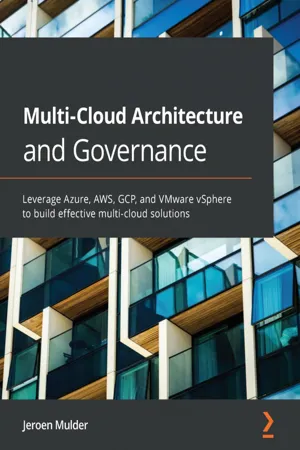
- 412 pages
- English
- ePUB (mobile friendly)
- Available on iOS & Android
Multi-Cloud Architecture and Governance
About this book
A comprehensive guide to architecting, managing, implementing, and controlling multi-cloud environments
Key Features
- Deliver robust multi-cloud environments and improve your business productivity
- Stay in control of the cost, governance, development, security, and continuous improvement of your multi-cloud solution
- Integrate different solutions, principles, and practices into one multi-cloud foundation
Book Description
Multi-cloud has emerged as one of the top cloud computing trends, with businesses wanting to reduce their reliance on only one vendor. But when organizations shift to multiple cloud services without a clear strategy, they may face certain difficulties, in terms of how to stay in control, how to keep all the different components secure, and how to execute the cross-cloud development of applications. This book combines best practices from different cloud adoption frameworks to help you find solutions to these problems.With step-by-step explanations of essential concepts and practical examples, you'll begin by planning the foundation, creating the architecture, designing the governance model, and implementing tools, processes, and technologies to manage multi-cloud environments. You'll then discover how to design workload environments using different cloud propositions, understand how to optimize the use of these cloud technologies, and automate and monitor the environments. As you advance, you'll delve into multi-cloud governance, defining clear demarcation models and management processes. Finally, you'll learn about managing identities in multi-cloud: who's doing what, why, when, and where.By the end of this book, you'll be able to create, implement, and manage multi-cloud architectures with confidence
What you will learn
- Get to grips with the core functions of multiple cloud platforms
- Deploy, automate, and secure different cloud solutions
- Design network strategy and get to grips with identity and access management for multi-cloud
- Design a landing zone spanning multiple cloud platforms
- Use automation, monitoring, and management tools for multi-cloud
- Understand multi-cloud management with the principles of BaseOps, FinOps, SecOps, and DevOps
- Define multi-cloud security policies and use cloud security tools
- Test, integrate, deploy, and release using multi-cloud CI/CD pipelines
Who this book is for
This book is for architects and lead engineers involved in architecting multi-cloud environments, with a focus on getting governance right to stay in control of developments in multi-cloud. Basic knowledge of different cloud platforms (Azure, AWS, GCP, VMWare, and OpenStack) and understanding of IT governance is necessary.
]]>
Frequently asked questions
- Essential is ideal for learners and professionals who enjoy exploring a wide range of subjects. Access the Essential Library with 800,000+ trusted titles and best-sellers across business, personal growth, and the humanities. Includes unlimited reading time and Standard Read Aloud voice.
- Complete: Perfect for advanced learners and researchers needing full, unrestricted access. Unlock 1.4M+ books across hundreds of subjects, including academic and specialized titles. The Complete Plan also includes advanced features like Premium Read Aloud and Research Assistant.
Please note we cannot support devices running on iOS 13 and Android 7 or earlier. Learn more about using the app.
Information
Section 1 – Introduction to Architecture and Governance for Multi-Cloud Environments
- Chapter 1, Introduction to Multi-Cloud
- Chapter 2, Business Acceleration Using a Multi-Cloud Strategy
- Chapter 3, Getting Connected – Designing Connectivity
- Chapter 4, Service Design for Multi-Cloud
- Chapter 5, Managing the Enterprise Cloud Architecture
Chapter 1: Introduction to Multi-Cloud
- Understanding what a true multi-cloud concept is
- A basic understanding of translating business requirements to a multi-cloud strategy
- An introduction to the main technology providers
Understanding multi-cloud concepts
-plgo-compressed.webp)
Multi-cloud – more than just public and private
Table of contents
- Multi-Cloud Architecture and Governance
- Why subscribe?
- Preface
- Section 1 – Introduction to Architecture and Governance for Multi-Cloud Environments
- Chapter 1: Introduction to Multi-Cloud
- Chapter 2: Business Acceleration Using a Multi-Cloud Strategy
- Chapter 3: Getting Connected – Designing Connectivity
- Chapter 4: Service Designs for Multi-Cloud
- Chapter 5: Managing the Enterprise Cloud Architecture
- Section 2 – Getting the Basics Right with BaseOps
- Chapter 6: Designing, Implementing, and Managing the Landing Zone
- Chapter 7: Designing Resilience and Performance
- Chapter 8: Defining Automation Tools and Processes
- Chapter 9: Defining and Using Monitoring and Management Tools
- Section 3 – Cost Control in Multi-Cloud with FinOps
- Chapter 10: Managing Licenses
- Chapter 11: Defining Principles for Resource Provisioning and Consumption
- Chapter 12: Defining Naming Conventions and Tagging
- Chapter 13: Validating and Managing Bills
- Section 4 – Security Control in Multi-Cloud with SecOps
- Chapter 14: Defining Security Policies
- Chapter 15: Implementing Identity and Access Management
- Chapter 16: Defining Security Policies for Data
- Chapter 17: Implementing and Integrating Security Monitoring
- Section 5 – Structured Development on Multi-Cloud Environments with DevOps
- Chapter 18: Designing and Implementing CI/CD Pipelines
- Chapter 19: Introducing AIOps in Multi-Cloud
- Chapter 20: Introducing Site Reliability Engineering in Multi-Cloud
- Assessments
- Other Books You May Enjoy